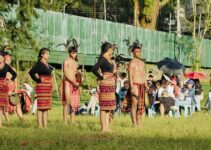You'll explore the remarkable impact of Indigenous leaders on Canadian politics. From advocating for Indigenous rights to championing environmental protection, these influential figures have shaped the political landscape. Get ready to delve into the stories of these leaders who have navigated the complexities of governance, carving out paths for future generations.
Key Takeaways
- Indigenous representation and political empowerment are reshaping the political landscape in Canada.
- Indigenous leaders, such as Jody Wilson-Raybould and RoseAnne Archibald, are actively advocating for Indigenous rights and justice.
- These leaders have a direct impact on shaping and influencing national policies, addressing Indigenous rights, land sovereignty, and self-governance.
- Indigenous leaders are actively working to increase Indigenous representation in government through electoral reforms and policy development.
The Rise of Indigenous Political Influence
You are witnessing a significant increase in Indigenous political influence across Canada. The rise of Indigenous representation and political empowerment is reshaping the country's political landscape. Indigenous leaders are gaining prominence in various levels of government, advocating for the rights and interests of their communities. This surge in political influence is evident in the appointment of Indigenous individuals to key government positions and the growing number of Indigenous representatives in federal, provincial, and municipal governments.
Indigenous communities are increasingly asserting their political voice and are actively participating in decision-making processes. The push for greater Indigenous representation has led to the implementation of policies aimed at increasing political empowerment among Indigenous peoples. As a result, Indigenous leaders are playing pivotal roles in shaping legislation and policies that directly impact their communities. This shift in political dynamics signifies a turning point in Canadian politics, as Indigenous voices are being amplified and heeded in matters of national importance. The growing Indigenous political influence is not only a testament to the perseverance of Indigenous communities but also a step towards a more inclusive and equitable political landscape in Canada.
Historical Indigenous Political Trailblazers
During the late 19th and early 20th centuries, Indigenous political trailblazers made significant strides in advocating for the rights and recognition of their communities within Canadian politics. Their unwavering determination and resilience laid the foundation for future indigenous political activism and historic indigenous movements. Below is a table highlighting some of the key historical Indigenous political trailblazers and their contributions:
| Trailblazer | Contribution | Impact |
|---|---|---|
| Louis Riel | Led the Red River and North-West Rebellions, fought for Métis rights | Galvanized the Métis people and raised awareness of their plight |
| Mary Two-Axe Earley | Advocated against discriminatory laws affecting Indigenous women | Paved the way for changes in Canadian citizenship laws and the Indian Act |
| Elijah Harper | Opposed the Meech Lake Accord, defended Indigenous rights | Gained widespread attention and respect for Indigenous perspectives |
These trailblazers played pivotal roles in shaping Canadian politics and raising awareness about the struggles faced by Indigenous communities. Their courageous actions and advocacy have left a lasting impact on the recognition of Indigenous rights within the political landscape. Transitioning to the subsequent section, it's essential to reflect on the legacy of these historical figures and examine the current indigenous leaders in Canadian politics.
Current Indigenous Leaders in Canadian Politics
Now, let's turn our attention to the present Indigenous leaders who are actively shaping Canadian politics. These notable figures have been influential in advocating for policies that address the needs and concerns of Indigenous communities. Their impact on Canadian policies is significant and deserves recognition in understanding the current landscape of Indigenous representation in Canadian politics.
Notable Indigenous Political Figures
As you delve into the landscape of Canadian politics, it is imperative to recognize the significant influence of current Indigenous leaders on the national political stage. These notable figures play a pivotal role in representing Indigenous communities and advocating for their rights, contributing to the broader representation in governance. Furthermore, they actively work towards the preservation of their cultural heritage, ensuring that their traditions and values are respected and upheld within the political sphere. Here are some notable Indigenous political figures shaping Canadian politics today:
- Jody Wilson-Raybould: A prominent leader advocating for Indigenous rights and justice.
- RoseAnne Archibald: The first female National Chief of the Assembly of First Nations, representing a significant milestone for Indigenous women in politics.
- Natan Obed: A strong advocate for the rights of the Inuit people and a vocal leader in Canadian politics.
- Georgina Jolibois: A dedicated advocate for Indigenous issues, serving as a Member of Parliament for the riding of Desnethé—Missinippi—Churchill River.
These leaders are instrumental in shaping policies and decisions that directly impact Indigenous communities, making their voices heard in the political arena.
Impact on Canadian Policies
With current Indigenous leaders in Canadian politics, you can observe a direct impact on shaping and influencing national policies. Their commitment to indigenous advocacy has been instrumental in driving policy reform. For instance, leaders like Jody Wilson-Raybould and Marc Miller have played pivotal roles in advancing policies that address indigenous rights, land sovereignty, and self-governance. Their active involvement in policy discussions and decision-making processes has led to a more inclusive approach to policymaking, ensuring that the unique needs and perspectives of Indigenous communities are considered and integrated into national policies. This has resulted in tangible changes, such as the implementation of initiatives aimed at addressing the socio-economic disparities faced by Indigenous peoples and the recognition of traditional indigenous knowledge in environmental and resource management policies. These leaders continue to be influential voices in shaping a more equitable and inclusive political landscape.
Indigenous Representation in Government
Now it's time to talk about Indigenous representation in government. Indigenous leaders have had a significant impact, but they also face challenges in achieving equal representation. Let's explore the progress made and the ongoing obstacles in Indigenous representation within Canadian politics.
Impact of Indigenous Leaders
Indigenous leaders' impact on Canadian politics is significant, as they actively work to increase Indigenous representation in government. Their efforts have led to tangible changes in the political landscape, bringing about greater diversity and inclusivity. Here's how they are making a difference:
- Advocacy for Electoral Reforms: Indigenous leaders have been at the forefront of advocating for electoral reforms that would ensure fair representation of Indigenous peoples in government.
- Creation of Indigenous Political Parties: Some Indigenous leaders have spearheaded the creation of political parties dedicated to representing the interests of Indigenous communities, providing a platform for their voices to be heard.
- Engagement in Policy Development: Indigenous leaders actively engage in the development of policies that address the unique needs and challenges faced by Indigenous communities, ensuring their perspectives are integrated into government decision-making.
- Mobilization of Indigenous Voters: Through community outreach and mobilization efforts, Indigenous leaders have played a crucial role in increasing Indigenous voter turnout, ultimately leading to greater political empowerment for Indigenous peoples.
Challenges and Progress
Facing significant challenges, you have made remarkable progress in increasing Indigenous representation in the Canadian government. Despite obstacles, the Indigenous political influence has been steadily growing. Indigenous leaders have successfully advocated for policies and initiatives that prioritize the needs and rights of Indigenous communities. The establishment of Indigenous caucuses and the appointment of more Indigenous individuals to key government positions have been crucial milestones in this progress. However, there are still significant hurdles to overcome, such as systemic barriers and historical injustices. The ongoing efforts to increase the number of Indigenous representatives in government, as well as the continued push for meaningful inclusion and decision-making power, are essential for further progress. While there is still work to be done, the advancements made in recent years are a testament to the determination and resilience of Indigenous leaders in shaping Canadian politics.
Key Indigenous Political Movements
You frequently encounter key Indigenous political movements shaping Canadian politics today. These movements play a crucial role in advocating for Indigenous rights and reconciliation efforts. Here are four key Indigenous political movements that are actively shaping Canadian politics:
- Idle No More Movement: This grassroots movement focuses on Indigenous land rights and environmental stewardship. It has brought attention to issues such as the protection of water resources and the impact of resource extraction on Indigenous lands.
- First Nations Child and Family Caring Society: This organization advocates for the rights of First Nations children and families, particularly in the context of child welfare and education. Their work has influenced government policies and funding related to Indigenous youth and families.
- Assembly of First Nations: As a national advocacy organization, the Assembly of First Nations works to address a wide range of issues, including land rights, treaty implementation, and economic development for Indigenous communities.
- Indigenous Climate Action: This movement focuses on environmental stewardship and climate justice within Indigenous communities. It advocates for Indigenous-led solutions to climate change and promotes sustainable practices rooted in Indigenous knowledge and traditions.
Challenges and Opportunities for Indigenous Political Figures
As a prominent Indigenous leader in Canadian politics, navigating systemic barriers while advocating for your community's interests presents both challenges and opportunities. The barriers you face are deeply entrenched, stemming from historical injustices and ongoing discrimination. These barriers include limited access to resources, underrepresentation in decision-making processes, and a lack of understanding of Indigenous issues among non-Indigenous political figures. However, amidst these challenges, there are also opportunities for you to effect change and empower your community. By actively engaging in political movements, you have the opportunity to elevate Indigenous voices and concerns, bringing about meaningful representation and policy changes. Your position allows you to challenge and reshape the existing political landscape, creating a more inclusive and equitable system. Furthermore, through your leadership, you have the opportunity to inspire and empower the next generation of Indigenous political figures, fostering a legacy of representation and advocacy. Embracing these opportunities amidst the barriers you face is crucial in shaping a more just and inclusive political future for Indigenous peoples in Canada.
Frequently Asked Questions
How Does the Representation of Indigenous People in Canadian Politics Compare to Other Countries?
In terms of the representation of indigenous people in Canadian politics, it's important to consider a comparative analysis with international perspectives. This allows for a broader understanding of the challenges and successes faced by indigenous communities in the political arena. By examining how other countries approach indigenous representation in their political systems, you can gain valuable insights into the different approaches and their potential impact.
What Role Do Indigenous Political Leaders Play in Addressing Environmental and Land Rights Issues?
Indigenous political leaders play a crucial role in addressing environmental and land rights issues. Their impact on policy making directly affects community representation. Did you know that in Canada, Indigenous leaders have led successful campaigns to protect land and water, such as the Idle No More movement? They bring unique perspectives and advocate for sustainable practices, influencing decisions that protect their communities and the environment.
How Have Indigenous Political Movements Influenced the Policies and Priorities of Mainstream Political Parties in Canada?
Indigenous political movements have significantly influenced mainstream party priorities in Canada. The influence on policies by Indigenous leaders has led to a shift in mainstream political party agendas, with a greater focus on Indigenous issues such as land rights, environmental protection, and reconciliation. This influence has prompted mainstream parties to incorporate Indigenous perspectives and prioritize Indigenous concerns within their platforms, showing the significant impact of Indigenous political movements on Canadian politics.
What Are Some of the Unique Challenges That Indigenous Political Leaders Face in Navigating the Canadian Political Landscape?
Navigating the Canadian political landscape presents unique challenges for Indigenous political leaders. They face obstacles in representing their communities while also being compared to non-Indigenous politicians. The struggle for adequate representation and the need to balance cultural values with political priorities are constant challenges. Despite these hurdles, Indigenous leaders continue to make significant strides in shaping Canadian politics.
How Have Indigenous Political Figures Worked to Promote Greater Cultural and Linguistic Diversity Within Government Institutions?
You've asked about how Indigenous political figures have promoted greater cultural and linguistic diversity within government institutions. Picture this: by advocating for inclusive policies, Indigenous leaders have empowered their communities, revitalized their cultures, and preserved their languages. They've worked to ensure that government institutions reflect the rich diversity of Indigenous peoples. Through their efforts, they've promoted inclusion and strengthened the representation of Indigenous voices in the political landscape.
Conclusion
You've learned about the influential indigenous leaders shaping Canadian politics, paving the way for future generations. Just like the strong roots of a towering tree, these leaders have established a firm foundation for indigenous representation in government. Their resilience and determination have allowed them to weather the challenges and grow, creating a canopy of opportunity for their communities. Keep an eye on these leaders as they continue to make waves in Canadian politics.



